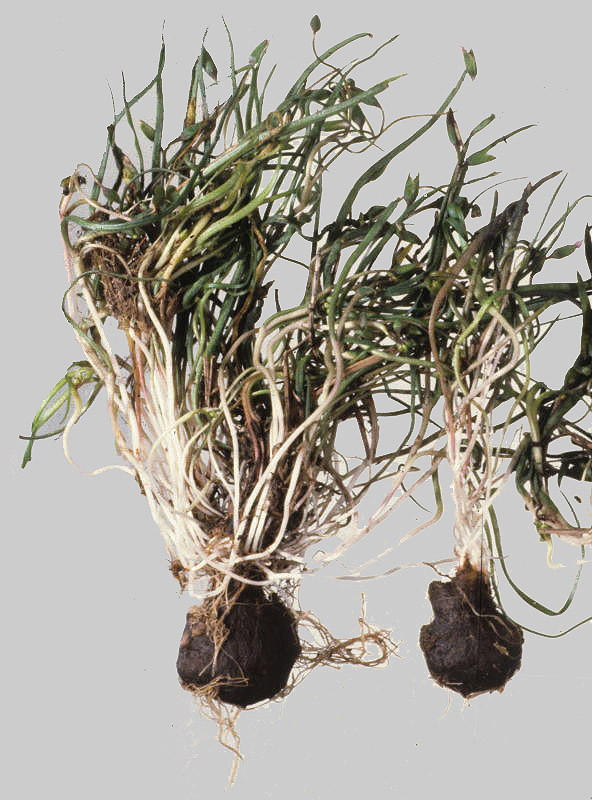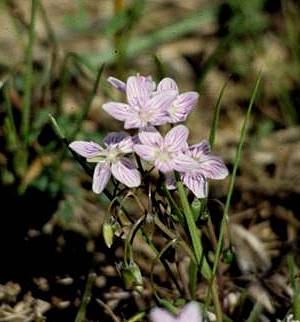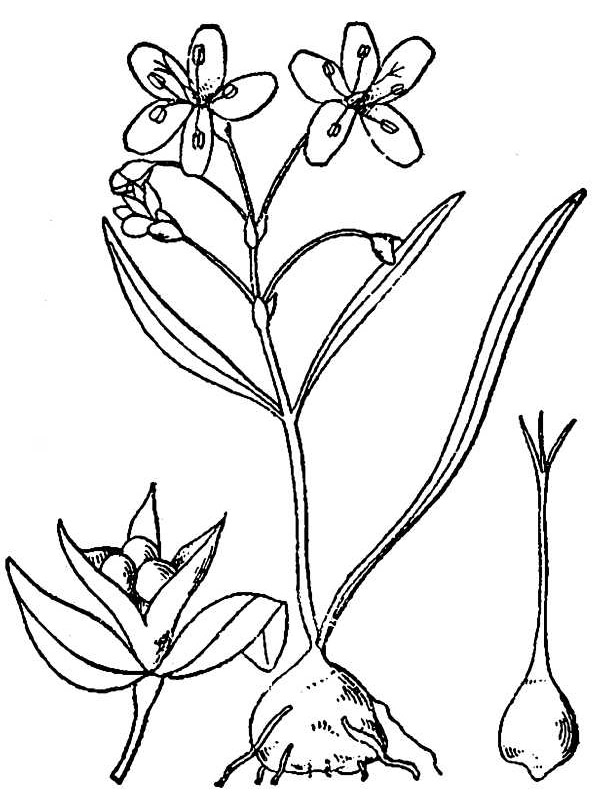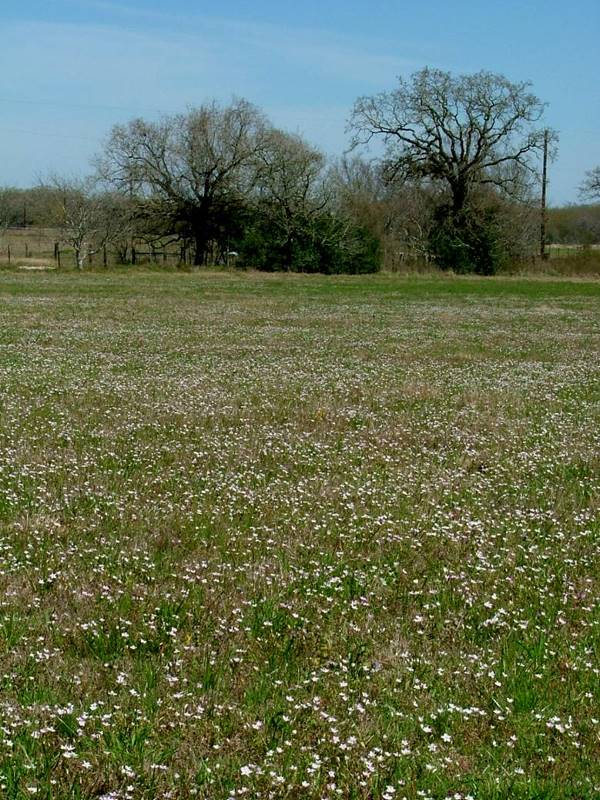Spring Beauty
Claytonia virginica L.
Portulacaceae — Purslane Family
Spring beauty is widely distributed across the eastern third of Texas, growing in sandy soil, and is found along sandy stream terraces across the upper coastal plains. Other species of the same genus grow in the northwestern areas of North America, including Claytonia lanceolata, C. caroliniana, C. multicaulis, and C. parviflora. The delicate herbaceous perennial springs from a thumb-sized, edible corm, in the spring, of course.
Texas lacks any ethnographic record that directly mentions spring beauty use. The only direct observation of root foods along the coast, that of Cabeza de Vaca, does not name or adequately describe any of the roots he used. We are left, therefore, with the job of seeking out those plants that grow along the coast, and are mentioned as useful or edible root foods elsewhere. Spring beauty is certainly one of those plants.
Food. There is a rich ethnographic record for spring beauty because Native Americans used it everywhere it grows. In geographic areas were spring beauty grows and ethnographic observations or interviews have been recorded, spring beauty is mentioned. Both the greens and the corm were eaten, and the plant had several medicinal uses as well. The corm contains an ample store of carbohydrates and spring beauty can grow in dense stands, making it a profitable source of calories. Yanovsky and Kingsbury (1938) included spring beauty in a survey of Native American food plants. Claytonia lanceolata corms from Utah contained roughly double the amount of reducing sugars as non-reducing sugars, along with a relatively high starch content. This translates to an easily processed plant that requires less cooking time than one with very large quantities of non-reducing sugars (eg. inulin).
Root/corm. Claytonia virginica, the species that grows in Texas, is distributed across the eastern third of North America. As a result, the ethnobotanical record originates from Algonquian and Iroquois sources. Algonquin use included cooking the corms and eating them as a root food “like potatoes” (Black 1980: 84). This particular record does not specify how they were cooked, however, potatoes may be baked or boiled or even eaten raw, and the records describing the uses of many other spring beauty species mention each of these preparation methods.
The richest ethnobotanical record for spring beauty comes from the Pacific Northwest. There several species of Claytonia grow, and the records have noted its use as food and medicine. In this region the uses and preparation of spring beauty are described more completely. The Thompson prepared spring beauty corms for storage by pit-baking or steaming them. The cooked corms were made into cakes, flat cakes, and dried. The Thompson also buried the fresh corms for use in the winter season, apparently storing them just as one would store an Idaho potato.
The corm of spring beauty is crisp and relatively high in starch and digestible sugar, allowing it to be eaten raw. Several groups, including the Yurok, Tolowa, and Karok of northern California, ate the plant raw (Baker 1981).
Greens. This brings us to the next use of spring beauty: as a source of greens. In the Pacific northwest as well as the Great Basin, spring beauty is also known as miner's lettuce. Chesnut (1909:346) notes that the Indians of Mendocino, California ate “. . . the whole plant raw or cooked up with salt and pepper for greens.” By whole plant he means everything above ground surface, because he lists Claytonia as a source of greens and not as a root food. The greens were eaten by several groups, including the Kawaiisu and several Californian groups, including the Costanoan, Luiseño, Miwok and in southern California by the Cahuilla and Santa Ysabel Indians (Bean and Saubel 1972; Bocek 1984; Hedges and Beresford 1986; Zigmond 1981).
Medicine. The greens were used as a poultice to treat a variety of ills. The Thompson Indians applied a poultice of spring beauty to eyes to aid vision (Turner et al. 1990) or simply dripped the sap of the plant into the eyes. The Hesquiat of Vancouver Island applied a poultice of masticated leaves to cuts and sores (Turner and Efrat 1982). The Cowlitz used an infusion of stems/greens as a hairwash to treat dandruff. The Snohomish, Queleute, skykomish, and Cowlitz used the plant on their hair as a tonic to make hair glossy. (Gunther 1973). The Quielite and Quinault also used the plant as a urinary aid (prostate shrinker, perhaps?) and as an eyewash. The Skagit used an infusion of the whole plant to treat sore throats (Gunther 1973). Perhaps one of the more unusual medicinal applications notes that pregnant Quinalt women chew the whole plant so that the “baby will be soft when born” (Gunther 1973:29).
Conclusion. It is clear from this survey that spring beauty was widely used as a root food, a source of greens, and for several medicinal applications. The record therefore strongly suggests that spring beauty was utilized by Native Americans wherever it grew. Thus it may be one of the root foods that Cabeza de Vaca encountered during his stay with Native Americans on the Texas coast.
References
Baker, Marc A.
1981 The Ethnobotany of the Yurok, Tolowa, and Karok Indians of Northwest California. Unpublished Masters Thesis. Humboldt State University.
Blankenship, J. W.
1905 Native Economic Plants of Montana. Montana Agricultural College Experimental Station, Bulletin 56. Bozeman.
Bean, Lowell J. and Katherine S. Saubel
1972 Temalpakh: Cahuilla Indian Knowledge and Usage of Plants. Malki Museum Press. Morongo Indian Reservation, Banning, California.
Black, Meredith J.
1980 Algonquin Ethnobotany: An Interpretation of Aboriginal Adaptation in South Western Quebec. National Museums of Canada. Mercury Series Number 65 Ottawa.
Bocek, Barbara
1984 Ethnobotany of the Costanoan Indians, California, Based on Collections by John P. Harrington. Economic Botany 38:240-255.
Chamberlin, Ralph V.
1911 The Ethno-Botany of the Gosiute Indians of Utah. Memoirs of the American Anthropological Association 2(5):331-405
Chesnut, V. K.
1902 Plants Used by the Indians of Mendocino County, California. Contributions from the U.S. National Herbarium 7(3):291-422.
Gunther, Erna
1973 Ethnobotany of Western Washington. University of Washington Press. Seattle.
Hedges, M., and C. Beresford
1986 Santa Ysabel Ethnobotany. San Diego Museum of Man -- Ethnic Technology Notes no. 20. San Diego, California.
Turner, Nancy J., Laurence Thompson, M. Terry Thompson, and Annie Z. York
1990 Thompson Ethnobotany: Knowledge and Usage of Plants by the Thompson Indian of British Columbia. Royal British Columbia Museum. Victoria, B.C.
Turner, Nancy J., and and Barbara S. Efrat
1982 Ethnobotany of the Hesquiat Indians of Vancouver Island. British Columbia Provincial Museum. Victoria, B.C.
Zigmond, Maurice L.
1981 Kawaiisu Ethnobotany. University of Utah Press. Salt Lake City.

|

|

|
